Image Credit: Energy Vanguard
Image Credit: Energy Vanguard Radiant heat flow in an attic effectively transfers heat from the roof deck to the solid materials on the attic floor. From there, much of that heat conducts downward into the house.
Image Credit: Energy Vanguard
Three years ago I wrote an article titled, Don’t Let Your Attic Suck: Power Attic Ventilators Are a Bad Idea. Nearly a hundred thousand page views and 93 comments later, it’s still generating lots of heat. I don’t know why so many people are so defensive about powered attic ventilators (PAVs), but here are a few of the things they’ve said to me in the comments:
You really should do more research before you post blogs like this.
Common Sense!!!! is in the building world, you really ought to check it out sometimes.
I challenge you to a battle of applied knowledge in this field any day, it’s people like you who make people who need an attic fan second guess themselves out of speaking with a true professional.
Oh, and let’s not forget: “You just are not getting it lady…” Last week I got another one so clever and witty I was at a loss as to how to respond. As it has mild profanity, I’ll post it at the end so you can avoid it if you’d like. With so many delicate construction types hanging around here at GBA, I try to be sensitive to your needs. ;~)
One reason powered attic ventilators don’t help
In my original article, I focused on makeup air. That is, I said that when you run a powered attic ventilator in a typical house, yes, it will cool the attic down. A significant amount of that cooling is likely to come from conditioned air being sucked up from the house below. Most ceilings aren’t air-sealed well, so putting a negative pressure on the attic will do that. I quoted Peter Yost in the earlier article, and in the comments, David Butler made a similar remark:
“In a particular home, if a PAV truly reduces cooling costs enough to pay for itself (don’t forget to consider the energy the fan consumes), then that tells me there are issues with ceiling insulation and/or attic venting.”
That’s as true today as it was three years ago when I wrote the first article. And it’s part of the reason that my state, Georgia, has banned power attic ventilators (unless they’re solar-powered, which was a concession needed to get the grid-powered fans banned). But there’s really a more fundamental reason that powered attic ventilators won’t help a lot, and for some reason, I didn’t mention that in the original article.
The #1 reason
How does heat get into the attic? Well, it starts at the sun and radiates down to the rooftop. We make sure that most rooftops can soak up as much heat as possible by using asphalt shingles. They’re often dark-colored. They’re granular. And many roof surfaces are tilted toward the sun for enhanced absorption.
That heat then conducts down through the roofing materials. The underside of the roof deck can get very hot — so hot you can’t keep your hand on it. At temperatures of 150°F or more, that’s a lot of heat sitting there in that plywood or OSB. Some of it will go directly into the attic air by conduction, but that’s a small amount because air isn’t a good conductor.
The main way that heat gets into the attic is through radiation. That hot roof deck radiates heat down into the attic. But that radiant heat passes through the attic air and hits the solid materials. It gets absorbed by the framing, insulation, the stuff you’re storing up there, and, unfortunately, any ductwork and HVAC systems that are up there.
Those materials heat up. They give up most of their heat by conducting it downwards into the house or into the ductwork and HVAC system and then into the house from there. Some of that heat gets into the air above the hot materials on the attic floor, but the attic air getting heated up is a secondary effect. See it now? Here it is: Using a fan to blow hot air out of the attic doesn’t address the radiant heat flow from the roof to the attic floor. Much of that heat then conducts downward and finds its way into the house.
Trying to solve the heat gain problem in your attic by using a fan is like lying out at the beach with a fan blowing over you and thinking you’re not going to get a sunburn.†A radiant barrier would be a better way to attack this problem, but the cost-effectiveness of radiant barriers is marginal.
The clever comment
Well, I promised I’d share the wisdom of the latest commenter with you, so here it is: “OK… I’m going to say it because no one else will… Allison Bailes, you’re an ASS!! :-)”
It makes me feel so much better that he used that smiley face at the end. ;~)
Powered attic ventilators cause problems
I’ve been in lots of attics. I’ve seen lots of powered attic ventilators, including the one in the top photo. That one was hooked up at one of the gable vents. The other seven fans in the attic were spread across the roof, and they were naturally fighting against each other. There’s no way there was enough open vent area in that attic to supply all eight of those fans.
In another home, I found three powered attic ventilators in the roof. We had been called in to solve a mold problem in two of the bathrooms, and those three fans turned out to be the main problem. We turned them off and the negative pressure pulling humid outdoor air into the bathrooms has gone away.
Allison Bailes of Decatur, Georgia, is a speaker, writer, energy consultant, RESNET-certified trainer, and the author of the Energy Vanguard Blog. Check out his in-depth course, Mastering Building Science at Heatspring Learning Institute, and follow him on Twitter at @EnergyVanguard.
Footnote:
†My friend Mike Barcik gets credit for this analogy, except that when he tells it, you’re lying naked in the sun. Naturally, this being a family blog and all, I don’t talk about naked people here. (And no – that’s not me in the photo.)
Weekly Newsletter
Get building science and energy efficiency advice, plus special offers, in your inbox.

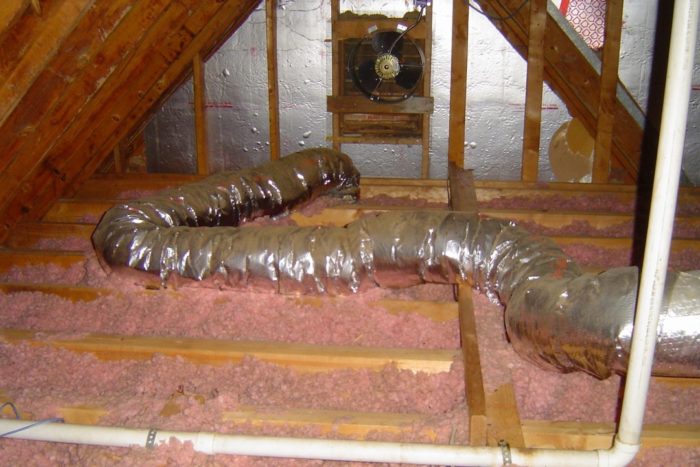




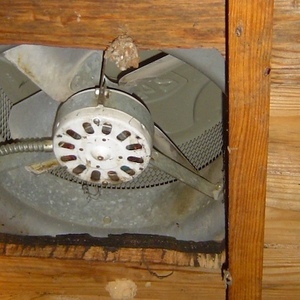
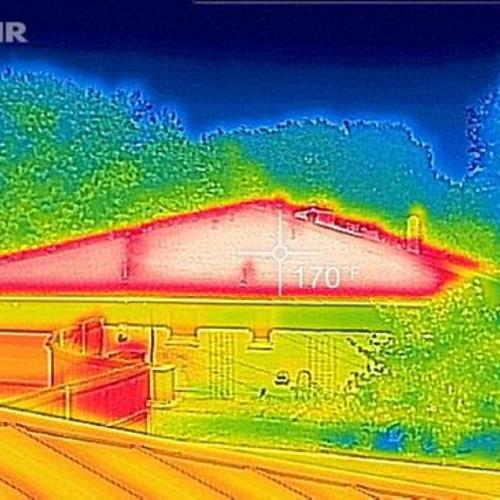
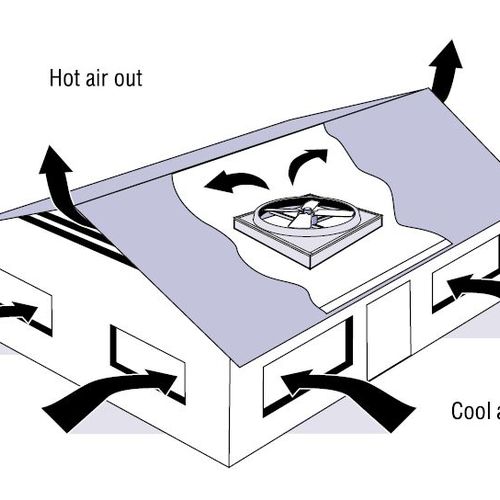
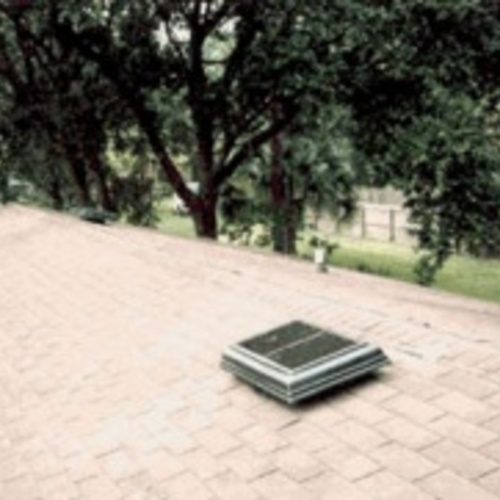






8 Comments
.... keep it cool in the first place ...
Instead of money and mechanicals (and the other problems outlined by Allison) to exhaust overheated attics, why not keep them cool in the first place. This is a perfect reason for a cold roof design (i.e. finished top isolated from deck by airspace and a ventilation plain), as well as other considerations such as insulated rafters, and either low solar absorption (reflective) tops or fast heat releasing materials (steel).
The Cold Roof assembly being the most significant and obvious way to not have this and a bunch of other problems in the first place.
Stop the heat at the roof, definitely, but...
Allison says: "Using a fan to blow hot air out of the attic doesn't address the radiant heat flow from the roof to the attic floor. Much of that heat then conducts downward and finds its way into the house."
To me, this statement doesn't prove the theorem of the title "Powered Attic Ventilators Are a Waste of Money"
Because it's just not true for a well insulated attic.
Yes, the radiant heat ignores the attic air as it heats up the top layer of the attic insulation, but the radiant heat is definitely stopped by that layer.
Then, the top of the insulation heats up and starts conducting heat (slowly) downward. If this layer has lots of outdoor air flowing across it, it will cool down close to the outdoor temperature, and most of the attic heat will be prevented from entering the house.
Example: A typical attic can reach 150F without forced ventilation. At that temperature, it will drive 4 times more heat into the house compared to a 90F ventilated attic. (Because the temperature difference is four times greater)
Response to Kevin Dickson
Kevin,
You are correct that lower attic temperatures will reduce the amount of heat flowing downward through the insulation on the attic floor. However:
1. Most people overestimate the effect of attic venting on attic temperatures.
2. If the house in question has enough insulation on the attic floor to meet minimum code requirements (R-49 in Climate Zone 6 or R-38 in Climate Zone 4), a change in attic temperature from 150 degrees F to 90 degrees F -- an unlikely change, by the way, since most attic ventilation strategies don't result in such a 60 degree swing -- won't have much of an effect on the thermal performance of the insulation layer or on energy bills.
You are Ignoring Attic Thermal Mass
I've never owned a house with central air conditioning, and I've experimented with all the ways to stay cool.
Imagine this scenario:
1. Summer day, 95 ambient high temperature.
2. Attic air temperature is 150F at 5pm. That means that the average temperature of the attic insulation is about 115F.
3. Evening ambient temperature, 70F at 10pm, bedtime is 11pm.
At 10pm, I throw open all the windows and place cheap box fans at windows and doors. By 11pm, the inside temperature is down to a tolerable 75F, so I turn off all the fans and go to bed. At 11:30 I wake up too warm because the 115F attic insulation and framing is trying to give up half of its heat to the house.
The best (non AC) solution is a quiet whole house fan that I can keep running through the night. It discharges to the attic, thereby cooling it while the house continues to cool.
If the attic had powered ventilators, I could have kept the the attic at a much lower temperature during the day, say 100F, leaving the average attic thermal mass at about 90F instead of 115F. I'm saying that's probably worth it, especially if I'm trying to avoid installing central air.
The most important takeaway from this is that in a climate that needs cooling, always put the attic inside the conditioned envelope and the insulation at the roof plane.
Response to Kevin Dickson
Kevin,
The number of Americans who have a insulation on their attic floor that reaches an average temperature of 115 degrees F is quite small.
Most people who live in a climate where attic insulation might get that hot have air conditioning. That means that the bottom levels of their attic insulation will be at room temperature.
Even homeowners without air conditioning often use strategies that cool the interior of their homes. These strategies include the use of evaporative coolers or the use of whole-house fans at night -- fans which cool the interior of the house. Once the windows are closed in the morning, it is unlikely that the ceiling Sheetrock will reach 90 degrees, as your posit.
So the mechanism you propose is possible but unlikely. That said, I agree with your conclusion that homeowners in the category you are talking about -- people who live in hot climates without air conditioning -- are better off locating their insulation at the roof plane instead of the attic floor.
Reply to Kevin Dickson
Martin has already said it, but if the attic is well insulated—and well air-sealed is important, too—that only makes the case against PAVs stronger.
By the way, a typical attic does not reach 150° F. It might get up to 120° F in the middle of the attic. Near the attic floor where the insulation is, it will be cooler. There's almost no way the average temperature of the insulation is ever going to be 115° F.
I've attached a graph from FSEC showing the temperature in a vented attic vs. that in a sealed attic. You can read much more about attic and shingle temperatures in the report, which you can download at:
FSEC-CR-1496-05 (pdf)
Reply to Martin and Allison
OK guys, thanks for helping me flesh this out:
Although an attic can store up some solar heat that can radiate downward all evening, forced attic ventilation is not a cost effective way to deal with it. It is usually worse than nothing in a house with AC, and not very helpful in a house with no AC.
Helping an attic ventilator relax
A few years ago I was asked to help improve the energy efficiency of a house built in the early 1920s in North Carolina. One part dealt with the attic which was observed to reach 120F+ in summer. The roof was black asphalt shingles and shaded for only part of the day. There were two undersized gable vents and a centrally located power vent fan that ran most of the day and some of the night during summers. The fan had a blade of about 15" dia. and worked on a thermostat set to come on at about 115F. The fan had an annoying rattle.
After doing some sealing work, several inches of unfaced fiberglass batt were added to the attic floor. That didn't change the attic much but it did relieve some of the a/c burden in the living spaces. The owner wanted to know why the attic temperature mattered since 'hot air rises, doesn't it?'. I said hot air DOES rise and when steady state occurs, it's still 120F up there and that 120F was what the insulation and other exposed surfaces were experiencing.
In addition, we then used kraft-faced fiberglass batt to fill between the rafters for about 50% of the deck underside surface. The rafters were a humble 2" x 4" array on 24" centers as I recall. Anyway, the attic temperature dropped dramatically to under 100F. The improvement was obvious. We reset the thermostat on the attic fan to 100F. The owner reported the rattling fan never ran after that. We verified it could still run. It just didn't need to. Hence the ventilator could relax. (I have no data on the corresponding winter effects.)
I followed a similar scheme to improve insulation in our current home in the Chicago area. Had I known about GBA, I might have gone to blown insulation and still may. When it came time to replace the roof, the contractor was surprised about the insulation in the rafters. However, he verified there was no moisture or mold or any difference versus rafter areas not so insulated. The attic has soffit ventilation and turtle type vents near the ridge line. There is no power ventilator and there is no need for one. Using cobwebs as a telltale, one can observe there is ongoing ventilation. The attic also benefits from a roof that I treated with some dilute white paint. This reduces the heat transfer to the shingles which themselves have a reflectivity at 0.26 as I recall.
I'm not claiming that each technique here is economically justified, I just have an aversion to auxillary equipment running to overcome a problem that doesn't need to be present.
Log in or create an account to post a comment.
Sign up Log in